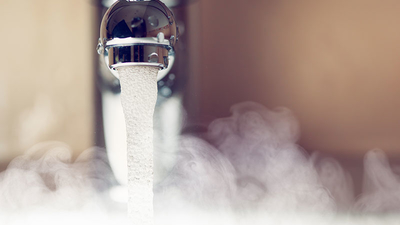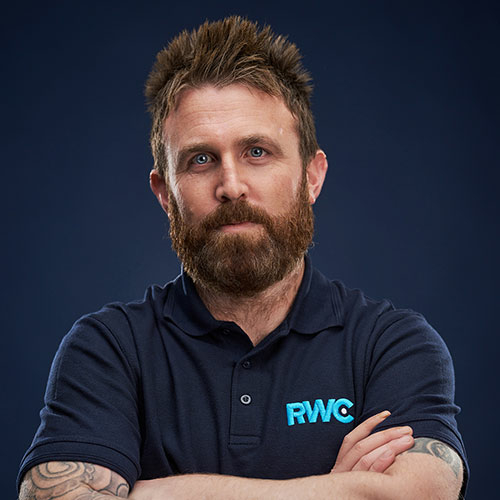All you need to know about surface mount plumbing

Historically, surface mount plumbing has been viewed either as a state-of-the-art plumbing technology on display for all to see, or a system better replaced by concealed plumbing, where pipework is hidden behind walls, cupboards, or specifically designed concealments.
But not only is surface mount plumbing making a big comeback in retro-style new builds, as well as refurbishment projects and the retrofitting of old buildings but also is often the only choice for specific project needs or particular parts of a plumbing system, like boilers.
In this blog, you will learn all you need to know about installing and maintaining a copper or chrome-plated plumbing system that is hidden in plain sight.
Easy access with surface mount systems
Surface mount plumbing is the practice of installing a plumbing system containing of pipes, valves, and fittings that are exposed – it is a plumbing system you can see. In most new builds or domestic homes with refurbished plumbing, pipework is concealed, either hidden behind walls or covered up by skirting boards, or specifically built cupboards and boxes. However, even in buildings with concealed plumbing, some features are always subject to being exposed, such as boilers, as that part of the systems needs to be easily accessible to allow for quick repairs and regular maintenance. Although, the whole boiler is then often hidden from view in a cupboard.
Naturally, a plumbing system that is exposed has an obvious advantage, as the easy access allows for straightforward repairs and maintenance. Plumbers and installers can simply access the section of the system that needs repairing without the need to remove a section of a wall or work in the confinements of a concealment, such as a space-restricting cupboard.

Installation need-to-know
Despite the fact that external surface mount plumbing systems are exposed, installation requires due diligence and serious care to get the system just right. One crucial factor to consider is that exposed pipework requires to be clipped into fittings secured to the wall, and the more extensive the layout of the pipework, the more clippings will be needed, as you want to prevent pipes from becoming loose or moving. Depending on the material used for the pipework, more clippings will be needed for heavier materials, as the system needs to be well supported. Installers also need to ensure that clips are spaced out evenly to ensure the exposed system is aesthetically pleasing. RWC recommends making use of our technical specification service, with our technical experts ready to give advice on best practice clip spacing, which is important to not only be even and aesthetically pleasing but more importantly that the right number of clips is used for the weight and purpose of the system that is being installed. And when planning and quoting work, installers need to bear in mind that this process requires some more time than other methods of installations and should plan accordingly.
When it comes to products used for surface mount plumbing systems, the important thing to consider is aesthetics. Where will the system be installed and how exposed it is? In most cases, the pipes installed in such plumbing systems are either copper or chrome plated as they are more visually appealing than plastic pipes. RWC’s SharkBite fittings and valves can be easily fitted onto copper or chrome-plated pipes and require no tools during installation. The pipes simply need to be cut, the fitting or valve pushed onto it, and you have an almost entirely leak-proof plumbing system, thanks to the fittings push-fit technology.
In instances where the pipework runs into a concealed area, such as a cupboard or skirting board, you can also use RWC’s JG Speedfit plastic push-fit fittings and valves, which are equally easy to install. Speedfit pipes can also be used in connection with SharkBite fittings, should a mixture of plastic and brass be desired, however, it is vital to ensure that plastic pipes are attached to the wall with sufficient amounts of clips.
The tools needed for installation will vary slightly depending on the material of the pipes. As mentioned above, pipework used for surface mount plumbing is usually copper or chrome-plated for aesthetic reasons, but in some cases might also be plastic. Installers will therefore either need copper cutters or pipe slicers to cut the pipes into the required length and if used with JG Speedfit (plastic) or SharkBite (metal) push-fit fittings, the connection will only require a simple push-fit action. Regardless of pipe material, installers will also require a drill to secure clippings onto walls, as well as a tape measure to ensure clips are spaced evenly apart, and a level to make sure the pipework is installed straight.

What to look out for
When installing an exposed surface mount plumbing system, there are a few further details to bear in mind to get it just right, especially in relation to internal and external temperatures.
If the pipe in question is a cold pipe, such as a water main pipe, which is installed in a hot area, such as an airing cupboard, installers need to make sure the pipe is properly insulated to avoid condensation. Alternatively, if the pipe installed is a hot pipe, it needs lagging to avoid burning when touched. Pipes that are prone to freeze, for instance when installed outside or in an outbuilding, also require lagging to protect them from potential damage from extremely cold temperatures. Plastic pipes in direct sunlight on the other hand will either need to be covered up or painted over to avoid discolouration.
Ultimately, installing a surface mount plumbing system requires best practice and due diligence by installers to ensure the system is aesthetically pleasing despite being exposed.
If it is done right, the system can add a real wow factor to a retrofitted or refurbished building, or even a new build.
For the best product technical advice on the topic of surface mount plumbing, as well as our wider RWC family of brands featuring JG Speedfit, SharkBite, and Reliance Valves, please get in touch.
Our family of brands
Discover more about our growing family of integrated brands, brought together by leading global plumbing group RWC.
